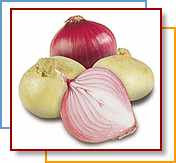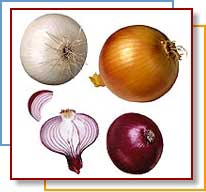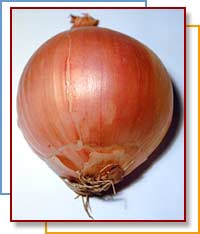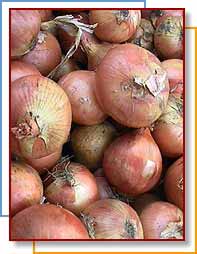
The onion is believed to have originated in Asia, though it is likely
that onions may have been growing wild on every continent. Dating back to
3500 BC, onions were one of the few foods that did not spoil during the
winter months. Our ancestors must have recognized the vegetable's
durability and began growing onions for food.
 The onion became more than just food after arriving in Egypt. The
ancient Egyptians worshipped the onion, believing that its spherical shape
and concentric rings symbolized eternity. Of all the vegetables that had
their images created from precious metals by Egyptian artists, only the
onion was made out of gold. The onion became more than just food after arriving in Egypt. The
ancient Egyptians worshipped the onion, believing that its spherical shape
and concentric rings symbolized eternity. Of all the vegetables that had
their images created from precious metals by Egyptian artists, only the
onion was made out of gold.
Today, onions are used in a variety of dishes and rank sixth among the
world's leading vegetable crops. Onions not only provide flavor; they also
provide health-promoting phytochemicals as well as nutrients.
Most onions are sold loose by the pound, although some types are sold
in bags or small boxes. Look for onions that feel dry and solid all over,
with no soft spots or sprouts. The neck should be tightly closed and the
outer skin should have a crackly feel and a shiny appearance. Onions
should smell mild, even if their flavor is not. Avoid selecting onions
with green areas or dark patches.
Onions should be kept in a cool, dry open space away from bright light.
Onions do best in an area that allows for air circulation. Because onions
absorb moisture, do not store onions below the sink. Also, do not place
onions near potatoes because potatoes give off moisture and produce a gas
that causes onions to spoil more quickly. Spring/summer onions usually
store for about two weeks and storage onions for about three to four
weeks.
 Onions came in a variety of sizes, colors and shapes. They are often
broken down into three categories: spring/summer, storage, and pearl
onions. Spring/summer onions are grown primarily from fall to spring in
warm weather areas and have a soft flesh and a mild or sweet taste. These
varieties are generally shipped right after harvesting. Storage onions
have a firm flesh, dry, crackly outer skins and have a pungent flavor.
After a brief period of drying, these onions are stored for several months
before shipping. Pearl onions are often called white onions and are
densely planted to make the onions smaller. There are no nutritional
differences among these onion types. Onions came in a variety of sizes, colors and shapes. They are often
broken down into three categories: spring/summer, storage, and pearl
onions. Spring/summer onions are grown primarily from fall to spring in
warm weather areas and have a soft flesh and a mild or sweet taste. These
varieties are generally shipped right after harvesting. Storage onions
have a firm flesh, dry, crackly outer skins and have a pungent flavor.
After a brief period of drying, these onions are stored for several months
before shipping. Pearl onions are often called white onions and are
densely planted to make the onions smaller. There are no nutritional
differences among these onion types.
Onions also come in three colors — yellow, red, and white.
Approximately 88 percent of the onion crop is devoted to yellow onion
production, with about 7 percent red onions and 5 percent white onions.
Yellow onions are full-flavored and are a reliable standby for cooking
almost anything. Yellow onions turn a rich, dark brown when cooked and
give French Onion Soup its tangy sweet flavor. The red onion, with its
wonderful color, is a good choice for fresh uses or in grilling and
char-broiling. White onions are the traditional onion used in classic
Mexican cuisine. They have a golden color and sweet flavor when sautèed.
Below are some onion varieties:
Variety
CARZALIA SWEETS
MAUI SWEETS
N.E. TRANSPLANTS
SWEET IMPERIALS
SWEET SPANISH
TEXAS SPRING SWEETS
VIDALIA SWEETS
WALLA WALLA SWEETS
|
Availability
June–August
Year Round
July–September
April–June
August–April
March–June
April–June
June–August
|
|
Source: National Onion Board
|
Onions may be eaten raw or cooked. Onions should be peeled before
preparing, except when baking. Onions may be boiled, braised, baked,
microwaved, or sautèed.
- According to an old English Rhyme, the thickness of an onion skin
can help predict the severity of the winter. Thin skins mean a mild
winter is coming while thick skins indicate a rough winter ahead.
- If you eat onions you can get rid of onion breath by eating parsley.
- Americans eat 18.8 pounds of fresh and storage type onions on
average each year.
|
|
Cooked Onions |
Serving
size 1/2 cup, chopped (105g)
|
Amounts
Per Serving |
% Daily
Value |
| Calories
45 |
|
| Calories
from Fat 0 |
|
| Total Fat 0g |
0% |
| Sodium 0mg |
0% |
| Cholesterol
0mg |
0% |
| Total
Carbohydrate 11g |
4% |
|
Dietary Fiber 1g |
4% |
|
Sugars 5g |
|
| Protein 1g |
|
| Vitamin A |
0% |
| Vitamin C |
10% |
| Calcium |
2% |
| Iron |
2% |
* Percent Daily Values are based on a
2,000 calorie diet. |
|
| |
|
|
|
|
Raw Onions |
Serving size
1/2 cup, chopped (80g)
|
Amounts
Per Serving |
% Daily
Value |
| Calories
35 |
|
| Calories
from Fat 0 |
|
| Total Fat 0g |
0% |
| Sodium 0mg |
0% |
| Cholesterol
0mg |
0% |
| Total
Carbohydrate 8g |
3% |
|
Dietary Fiber 1g |
4% |
|
Sugars 3g |
|
| Protein 1g |
|
| Vitamin A |
0% |
| Vitamin C |
8% |
| Calcium |
2% |
| Iron |
0% |
* Percent Daily Values are based on a
2,000 calorie diet. |
|
| |
|
|
Recipes
 Sweet
Onion-Pineapple Salsa Sweet
Onion-Pineapple Salsa
Serves 5 (1/2 cup servings each)
Each serving equals 1/2 cup of fruit or vegetables
(www.fruitsandveggiesmorematters.org*)
Ingredients
½ cup chopped sweet onion
2 cups pineapple
½ cup diced red bell pepper
1 tbsp chopped cilantro
1 tbsp chopped jalapeno
1 tbsp lime juice
Combine all ingredients, stirring until blended.
Nutritional analysis per serving: Calories 41, Fat 0g, Cholesterol 0mg,
Fiber 1g, Sodium 2mg.

Find more in our
recipe database!
|



